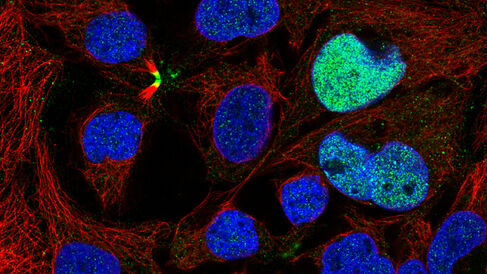
Josie Christopher and Kathryn Lilley, along with 13 authors from world-leading subcellular proteomics laboratories, have published a comprehensive review in Nature Reviews Methods Primers covering the major techniques in the field.
Just like us, proteins have jobs. Our jobs are various and diverse, and need to be performed in specialised places (our offices, workshops, and laboratories) with specialised people (our colleagues). Similarly, in cells, the specialised environments of organelles are where proteins work and interact with their 'molecular co-workers', such as co-factors and enzymes. This compartmentalisation of proteins within organelles is paramount for controlling protein function, signalling cascades and basic biological processes, including the cell cycle, proliferation, and programmed cell death. And again, like us going home to relax and cook dinner, some proteins can reside in or travel to additional organelles to fulfil multiple different roles. Identifying the subcellular/organellar locations of proteins can, therefore, help us to infer their functionality. Similar to the mishaps that may occur if we wander into a working environment with equipment that we are not trained to use, aberrant or mis-localisation of proteins in cells has been implicated in many pathological states1-2. Despite this, information on localisation is frequently overlooked in research, often favouring assessment of global changes in protein expression instead. With the similar global-stalking powers of Google, high-content subcellular proteomics has the capability for exhaustive exploration of both steady-state and dynamic localisations of proteins on a cell-wide level.
The review on subcellular proteomics in Nature Reviews Methods Primers aims to provide an accessible resource to members of the scientific community who may be new to the field and may be considering using spatial proteomic techniques in their research. The paper gives a broad overview of a diverse and complementary set of methods, which encompass imaging and mass spectrometry-based approaches, such as immunofluorescence, proximity tagging and organellar fractionation, as well as touching on novel development of these and alternative techniques. The content includes directly comparing these methods, highlighting practical considerations, limitations and relevant key papers, and their real-life applications to create a good knowledge base for the reader to guide them into taking their first steps into this field. With subcellular proteomics still rapidly expanding, the paper briefly speculates on where the field is heading and what to look forward to in the coming years.
Josie commented: "Co-authoring this review with world-leading groups in subcellular proteomics has been a welcome distraction from COVID-19 and an excellent way to connect globally despite the lack of in-person meetings. With expertise ranging from Sweden to Canada to Germany to the USA, this collaboration packages a broad, and sometimes daunting, topic into a novice-friendly resource with the hope to encourage more researchers to add these methods to their repertoire."
1 Hung M-C and Link W (2011). Protein localization in disease and therapy. J. Cell Sci., 124(Pt 20):3381-3392. doi: 10.1242/jcs.089110
2 Pankow S et al. (2018). Understanding molecular mechanisms of disease through spatial proteomics. Curr. Opin. Chem. Biol., 48:19-25. doi: 10.1016/j.cbpa.2018.09.016
